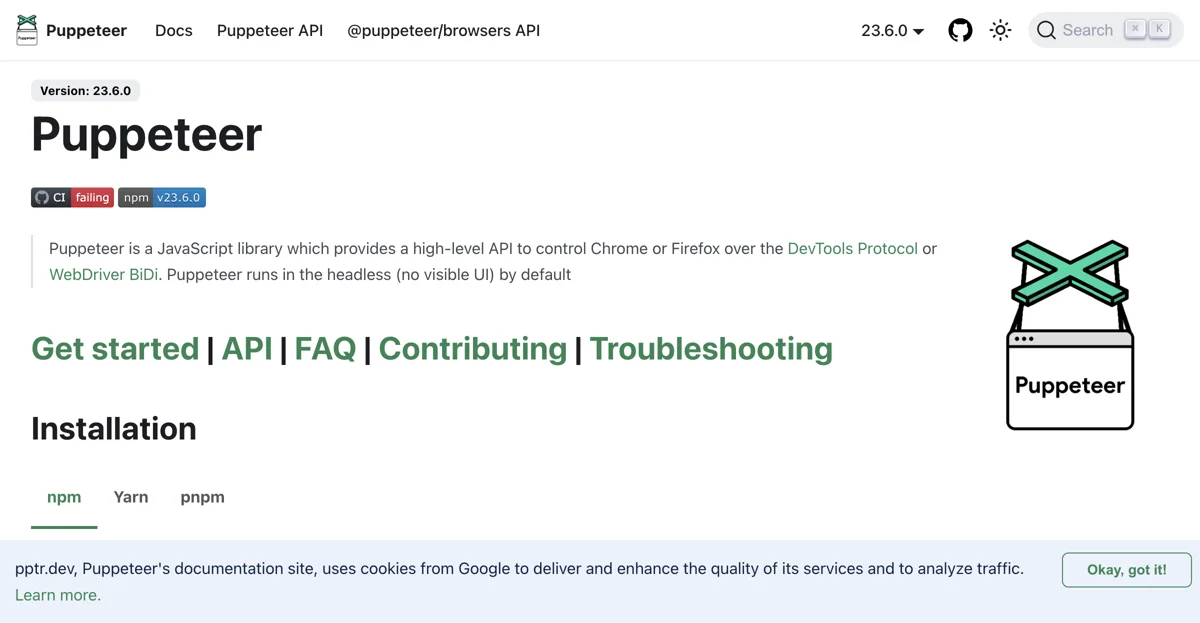Puppeteer is a remarkable JavaScript library that offers a high-level API to control Chrome or Firefox. It operates over the DevTools Protocol or WebDriver BiDi, providing developers with powerful capabilities. By default, Puppeteer runs in a headless mode, meaning there is no visible UI, which is particularly useful for various automation tasks. Installation is straightforward, with options available via npm, Yarn, and pnpm. The library allows for launching the browser and opening a new blank page, navigating to a URL, setting the screen size, and performing a variety of other operations. For example, it enables typing into search boxes, clicking on results, and locating and extracting text. The Puppeteer community is active on platforms like Stack Overflow, Twitter, and YouTube. Overall, Puppeteer is a valuable tool for web developers looking to automate and control web browsers efficiently.

Puppeteer
Puppeteer is a powerful JavaScript library for controlling browsers. Discover its features and capabilities for efficient web automation.

Top Alternatives to Puppeteer
Email Signature Parser
Email Signature Parser is an AI tool that extracts contact details and sends them to various platforms
Crawlbase
Crawlbase is an AI-powered web scraping platform that simplifies data extraction
Diffbot
Diffbot is an AI-powered data extraction tool that offers diverse solutions
Reworkd
Reworkd is an AI-powered web data extractor that saves time and costs
Web Scraper
Web Scraper is an AI-powered data extraction tool that simplifies web scraping.
ParseHub
ParseHub is a free, powerful web scraping tool that simplifies data extraction from any website without coding.
Datatera.ai
Datatera.ai is an AI-powered web scraping tool that transforms files and websites into structured data effortlessly.
PromptLoop
PromptLoop is an AI-powered platform that accelerates web research and data extraction, enabling users to automate tasks and gain insights efficiently.
Thunderbit
Thunderbit is an AI-powered web automation tool that helps users automate repetitive tasks, summarize content, and interact with webpages effortlessly.
Import.io
Import.io is an AI-powered web data extraction tool that enables businesses to gather high-value data efficiently.
SerpApi
SerpApi is an AI-powered Google Search API that helps users scrape and parse search results efficiently.
Bytebot
Bytebot is an AI-powered web automation tool that enables users to create and execute code-free automations for tasks like data extraction and form filling.
GoLess
GoLess is a no-code browser automation tool that enables users to automate web scraping, task automation, and spreadsheet workflows directly in their browser.
Rapture Parser
Rapture Parser is an AI-powered web scraping API that transforms any website into structured data effortlessly.
UseScraper
UseScraper is an AI-powered web scraping and crawling tool that enables users to extract and convert web content into markdown, plain text, or HTML formats efficiently.
WhatOnEarth | Search Engine
WhatOnEarth is an AI-powered search engine that offers both deep web scraping and fast offline model results.
Webtap.ai
Webtap.ai is an AI-powered web scraping tool that enables users to extract data from any website using natural language queries.
Extracto.bot
Extracto.bot is an AI-powered web scraper that automates data collection directly into Google Sheets, requiring no configuration.
Scrap.so
Scrap.so is an AI-powered data collection tool that automates web scraping, enabling users to gather and organize data effortlessly.
WebScraping.AI
WebScraping.AI offers a powerful AI-powered web scraping API that handles browsers, proxies, CAPTCHAs, and HTML parsing, simplifying data extraction.
FlowScraper
FlowScraper is an AI-powered web scraper that simplifies data extraction with its no-code flow builder.